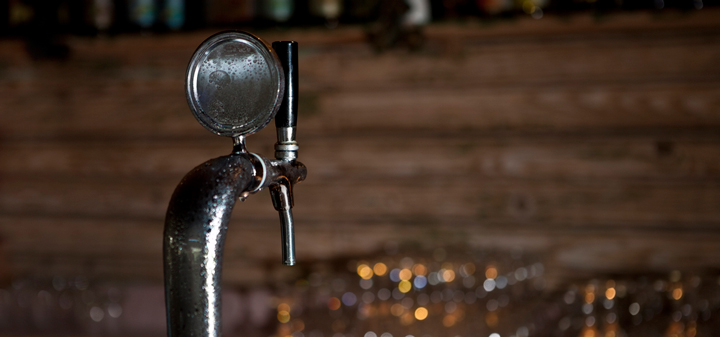
These days, keg wine — or wine on tap as most patrons would see it — is nothing new. In fact, in most major metropolises, there are at least a handful of restaurants and bars/lounges that not only serve keg wine, but proudly advertise it. But that wasn't always the case.
In one form or another, keg wine is one of the oldest ways to deliver wine, but these were wooden kegs. And serving from wooden kegs in relatively uncontrolled environments such as restaurants hasn't always proven best for the wine itself. In the 1970s, beermaker Anheuser Busch decided to bring keg wines into the present by selling keg wine in modern steel containers. They did so under the Master Cellars name, but never quite garnered the reaction they hoped for. Others would try as well, but low-end wine and underdeveloped technologies ultimately held the effort down.
And while more popular in Europe, in countres such as Italy, France, and Belgium, it is the United States that is taking the next step in innovation and attempting to indoctrinate high-end and boutique producers in packaging and distributing their wine via keg. Widely known Free Flow Wines began in 2009 with an idea to sell high-quality (albeit bulk) wine in kegs to restaurants. Now they have 75,000 kegs of approximately 440 wines in circulation, including wines from Frog's Leap and Trefethen, among others. Vintap was another company coming up then. Around the same time, or shortly before, Cindy Diffenderder, a pioneer in the space, started Grape Group. Coming from a craft beer background, she was intrigued by the potential of the industry, especially in the larger wine space which was, like craft beer, appealing to a much wider, more experimental audience.
“When I started out, keg wine was a very new, novel, kind of obscure idea,” Diffenderder says. “What I thought was really interested about it was the ability preserve great grapes, pour with consistency, and simplify the supply chain while passing along those cost savings where we get the efficiency to the retailer and, as a result, offer better wine for a better price.”
“I thought there was a great opportunity there — I previously came from the craft beer industry — and I very familiar with consumer consumption trends, and how they were shifting towards craft beer and wine at a double digit rate at the time. And they continued to grow. Having that experience with craft beer and thinking about where the trends were with wine is what got me intrigued.”
Now, Diffenderder runs Smart Wine, and she has seen that once-intriguing industry evolve from a couple coastal markets to a truly international endeavor.
Charles Bieler, a visionary winemaker and marketer (as well as compulsive), went a different route. One perhaps a little less voluntary.
“Wine on tap was an idea that was rattling around my brain,” the man behind Gotham Project shares, “but the real story was I was basically pushed into it by a friend, MS and Whole Foods National Wine Director Devon Broglie. In a late night drinking session he accused me of being sold out, and that I hadn’t brought anything new or innovative of late — so right then and there I had to defend my reputation and come up with an idea. As I mentioned, wine on tap was something of interest though was not at all on the ‘front burner’ at the time. But it’s all I could think of in the moment; I told Devon that I’d attack wine on tap. And so it began.”
“I should add that while I do enjoy championing categories of wines or formats that are initially unusual,” Bieler continues, “there has to be real merit to be worth doing. It can’t just be different as that wouldn’t have long term legs. It has to really add something to the wine canvas.”
And for Bieler, this packaging did.
But what, exactly, is keg wine? Utilizing pre-existing keg technology, but tailoring it to the specific needs of wine, companies like Smart Wine and Gotham Project package wine in in kegs (instead of bottles) in hopes of preserving quality across batches while substantially lowering costs.
So what does that mean?
“Wine on Tap has a couple primary aspects that are important and that order of importance changes depending on the person,” explains Bieler. “By eliminating the need for glass cork labels and foils we greatly reduce packaging needs which means we can pass along better value and reduce environmental impact. Did you know that in the United States 70 percent of glass goes straight to the landfill and 10% of the US landfill be weight is glass? We use reusable stainless steel kegs which have a 30 year life span and we try to turn it over four times a year so a 19.5 L keg eliminates some 250 cases worth of glass and material over the course of it’s lifespan.
“And maybe the bigger issue is freshness. At restaurants, by the glass is tough to manage. Bottles are often opened long before when they are served and thus are often in the decline meaning a customer doesn’t get an optimal experience. With a properly set up draft system, every glass should taste fresh and as it should, no matter if it was a slow night or the restaurant was closed or whatever. In summary, it allows a better glass of wine."
The advantages are clear: reduced packaging and shipping costs results in reduced prices for consumers; low oxidation and spoilage; and possibly most important — no waste at the end of bottles. But these advantages are not always obvious to consumers, though, and initially it was difficult to convince winemakers and retailers alike that it would be worth their while.
Every winemaker Diffenderder approached, it seemed as if she came accompanied by an indescriably bad omen, even the reaper: "When I started Grape Group, when I was looking to purchase bulk wine with the intent of packaging it in kegs, I couldn’t find any vendors — except one. I was shocked."
Despite paying up front, in cash no less, these potential clients were adamant that they would not be affiliated with the newfangled package as they deemed it inferior. Retailers, however, were more of a mixed reaction. To begin, commercial operators were as resistant as winemakers were, even with the most to gain. They were largely hesitant under the impression that customers would not want wine on tap as they would associate it with box wine, or bad wine.
"Now, box wine truly is an inferior product compared to stainless steel — that process taints the liquid, cause even if the liquid was good going into the bag, it is not good coming out," Diffenderder interjects. "So in the sense of comparing the bulk dispensing mechanism, one to another, there was that native idea that the customer is going to think it’s box wine, and therefore think it is bad wine."
Bieler empathizes: "Costumers look to packaging and format to suggest quality and wine on tap can be perceived by some as low quality. Of course the worst wine in the world can be in a big heavy bottle with a label with fancy gold script and still taste terrible."
This lack of willingness to experiment might have been intrinsically connected to a lack of confidence. Higher end establishments, namely European restaurants, did not suffer from such a lack of confidence. On the contrary, they were quite confident that they could shift the opinion of the buyer before it was ever tainted. For them, they had reputations that proceeded them, and understanding the economics of consistency and eliminating waste, were convinced that they would be able to make keg wine (or tap as it would appear to the patron) cool. They already had the inherent endorsement that everything that came with their property was good.
Today, keg wine has comfortably found recognition and familiarity in coastal markets with progressive or otherwise transient patrons. More traditional strongholds, including within the wine industry itself, remain somehwat elusive. But that doesn't faze Diffenderder and Bieler, though. It is simply another obstacle to overcome.
"I suppose the main one is that the wine industry loves tradition and thus change is scary," Bieler says. "It’s just a vessle — keg, bottle or other — so we have to educate as to what the advantages are."
"Short term, the most critical education that takes place is the bartender, managers, and servers of our clients, ’cause they are the ones who sell our products," Diffenderder adds. "Also, right now, the wine industry doesn’t really have a branded reputation. So people aren’t really following you, with the obvious exceptions of a Veuve Clicquot or Yellowtail. Thus, consumer loyalty is more varietal and price points before a brand.
"Part of what we really pride ourselves in is innovation and sustainability. We’re a new-age winemaker. We’re recognizing you don’t have to be in the wine industry for a long time to make great wine — because you can align yourself with great winemakers. We’re really focusing on innovation, sustainability, and creating a better product at a better price."
And it seems like all of these innovators hard work is paying off, at least in the way of traction.
"The future looks bright! We are growing strongly. I suspect that we are looking at an overnight success that will take 10 years! Just as with screw caps, it’s taken a long time for consumers to gain comfort that it’s an excellent closure and protects wines, especially fresh wines, far better than cork."










